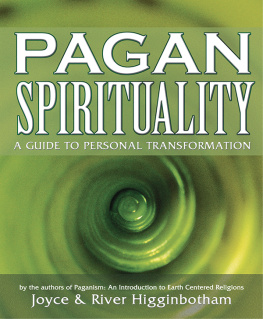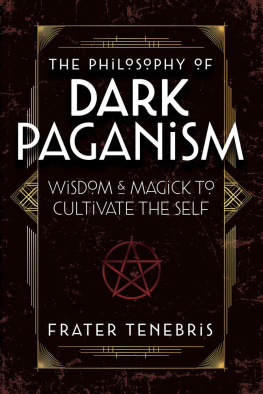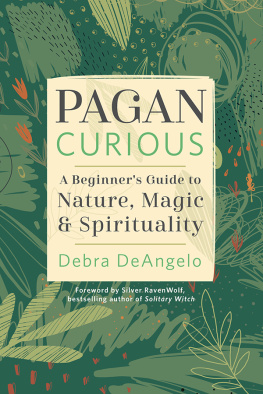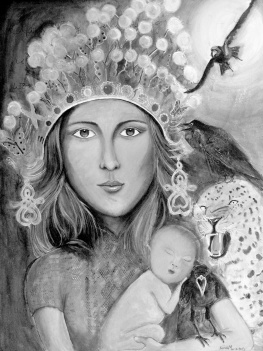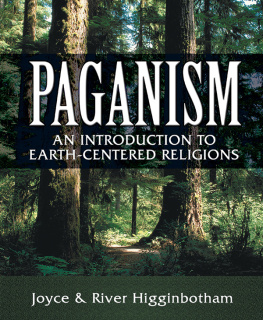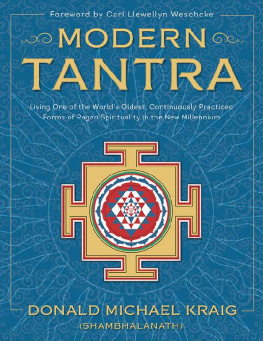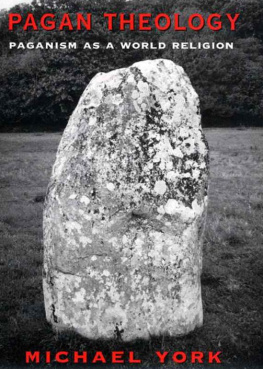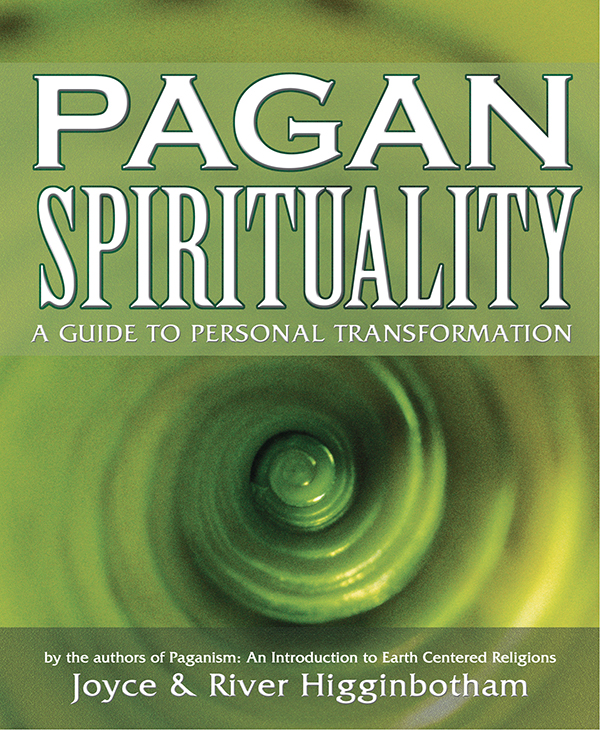About the Authors
Joyce and River Higginbotham have taught Paganism classes throughout the past decade. They have planned and organized local and national Pagan gatherings, written articles for Pagan publications, appeared on radio and television broadcasts, spoken at Christian and Unitarian Universalist churches, and attended interfaith councils. They also helped found the Council for Alternative Spiritual Traditions, which hosted public Pagan and alternative events in the Midwest.

Llewellyn Publications
Woodbury, Minnesota
Copyright Information
Pagan Spirituality: A Guide to Personal Transformation 2006 by Joyce and River Higginbotham.
All rights reserved. No part of this book may be used or reproduced in any matter whatsoever, including Internet usage, without written permission from Llewellyn Publications, except in the form of brief quotations embodied in critical articles and reviews.
As the purchaser of this e-book, you are granted the non-exclusive, non-transferable right to access and read the text of this e-book on screen. The text may not be otherwise reproduced, transmitted, downloaded, or recorded on any other storage device in any form or by any means.
Any unauthorized usage of the text without express written permission of the publisher is a violation of the authors copyright and is illegal and punishable by law.
First e-book edition 2012
E-book ISBN: 9780738724324
Book design and layout by Joanna Willis
Cover image 2005 by Comstock
Cover design by Gavin Dayton Duffy
Interior illustrations by Llewellyn art department
Llewellyn Publications is an imprint of Llewellyn Worldwide Ltd.
Llewellyn Publications does not participate in, endorse, or have any authority or responsibility concerning private business arrangements between our authors and the public.
Any Internet references contained in this work are current at publication time, but the publisher cannot guarantee that a specific reference will continue or be maintained. Please refer to the publishers website for links to current author websites.
The authors wish to thank and acknowledge Shambhala Publications for permission to incorporate and paraphrase material by Ken Wilber, Blackwell Publishers, Inc., for permission to paraphrase the eight colors of the spiral from Don Edward Beck and Christopher C. Cowans Spiral Dynamics: Mastering Values, Leadership, and Change , 1996, and Roman & Littlefield Publishers, Inc., for permission to reprint the figure Societal Types by Degree of Sex Stratification from Sex and Advantage: A Comparative, Macro-Structural Theory of Sex Stratification by Janet Saltzman Chafetz, page 115, 1984.
Llewellyn Publications
Llewellyn Worldwide Ltd.
2143 Wooddale Drive
Woodbury, MN 55125
www.llewellyn.com
Manufactured in the United States of America
This book is dedicated to Ken Wilber
For having thrown down the Gauntlet
and
To all those who courageously pick it up
And accept the challenge it offers to their spiritual growth
Contents
List of
List of
. Growth and the iIndividual
Growth as Expansion
The Growth Process
Developmental Space
Stages of Faith
Stage Demographics
Integrating the Models
Paganism and Personal Development
. Growth and Culture
Culture in Developmental Space
Spiral Dynamics
Paganism and Cultural Development
. Growth and Magick
Walking Meditation
A Review of Magick
More on Magickal Pages
Magickal Integration
What Do You Want Magickally?
Designing a Plan
. Communing
Opening to Communing
Communing and the Four Elements
Building Relationships
Communing in Developmental Space
Blessing Ritual
Checking in with Your Magickal Plan9
. Energy Work
Opening to Energy
Directing Energy
Energy Work and the Four Elements
Energy Work in Developmental Space
Blessing Ritual
Checking in with Your Magickal Plan
. Divination
Receiving Information
Working with Divination
Divination and the Four Elements
Divination in Developmental Space
Blessing Ritual
Checking in with Your Magickal Plan
. Conscious Creation
Stepping Into the Exchange
Conscious Creation and the Four Elements
Conscious Creation in Developmental Space
Blessing Ritual
Checking in with Your Magickal Plan
Final Thoughts
The Center Candle
Exercises
Figures
: Wilbers Nine Developmental Spaces
: Stage Demographics
: Correlation of Developmental Spaces, Dark Nights, and Stages of Faith
: Culture in Developmental Space
: Wilbers Four Quadrants
: Correlation of Developmental Models
: Degree of Sex Stratification by Societal Type
: Correlation of the Quadrants, the Directions, and the Elements
: A Nine-turn Labyrinth
: Correlation of the Labyrinth and Spiral Dynamics
: The Upper Left Quadrant: Communing, West, Inner I
: The Chakras
: The Lower Left Quadrant: Energy Work, South, Inner We
: The Lower Right Quadrant: Divination, East, Outer Its
: The Upper Right Quadrant; Conscious Creation, North, Outer It
Introduction
For more than a decade we have introduced people to the ideas and principles of the modern Pagan movement, teaching classes at churches, bookstores, homes, conferences, and festivals. Many of you reading this are already familiar with our introductory book, Paganism: An Introduction to Earth-Centered Religions , in which we set out a number of concepts central to modern Paganism.
As noted in our introductory book, there is debate among Pagans as to what name should be used to describe the modern movement so as to distinguish it from historical Paganism. The noted author and Druid, Isaac Bonewits, has developed what some consider a classic definition of the types of Paganism. Bonewits uses the word paleopaganism to describe the original tribal faiths of Europe, Africa, Asia, the Americas, Oceania and Australia. A few of these tribal faiths, such as Hinduism, Taoism, and Shintoism, whose adherents number in the millions, have survived to the present. He then uses the word mesopaganism to describe re-creations of paleopagan systems which are usually interwoven with influences from Judeo-Christianity. Some of the examples he gives are Freemasonry, Rosicrucianism, Theosophy, Voudoun, Santeria, and Sikhism. His third category is neo-paganism, which he defines as religions created since the 1960s which have attempted to blend what their founders perceived as the best aspects of different types of paleopaganism with modern Aquarian Age ideals.
For the sake of simplicity, we use the word Pagan throughout this book to refer to the modern neo-Pagan movement. If the focus of a section is on ancient peoples and cultures, then we will reference them explicitly.
When we began teaching classes about Paganism over a decade ago we immediately discovered that our students really yearned to connect spiritually, to find that point where they intersect with the universe, and to have an experience of being seen and heard by whatever has ultimate meaning for them. Their desire to develop active and creative spiritual relationships was strong, and was frequently what brought them to Paganism. As teachers and facilitators of the learning process, we began searching for ways to help our students connect. We created experiences we hoped would enable them to open to spiritual energies and take part in the constant and creative exchange of the universe. We introduced them to energy workings, manifesting, and divination skills. We offered them opportunities to listen to their inner selves, the natural world, and consciousness at large, and to commune with their concept of spirit and the Divine.

